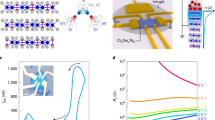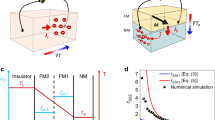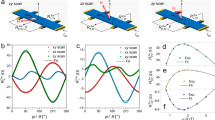Abstract
Electrical control of magnetic properties is crucial for device applicationsin the field of spintronics1,2,3,4,5,6,7,8,9,10,11,12,13,14,15,16,17,18,19,20. Although the magnetic coercivity or anisotropy has been successfully controlled electrically in metals 9,15,17 as well as in semiconductors6,10,11,13, the electrical control of Curie temperature has been realized only in semiconductors at low temperature4,5,8. Here, we demonstrate the room-temperature electrical control of the ferromagnetic phase transition in cobalt, one of the most representative transition-metal ferromagnets. Solid-state field effect devices consisting of a ultrathin cobalt film21,22 covered by a dielectric layer and a gate electrode were fabricated. We prove that the Curie temperature of cobalt can be changed by up to 12 K by applying a gate electric field of about ±2 MV cm−1. The two-dimensionality of the cobalt film may be relevant to our observations. The demonstrated electric field effect in the ferromagnetic metal at room temperature is a significant step towards realizing future low-power magnetic applications.
This is a preview of subscription content, access via your institution
Access options
Subscribe to this journal
Receive 12 print issues and online access
$259.00 per year
only $21.58 per issue
Buy this article
- Purchase on Springer Link
- Instant access to full article PDF
Prices may be subject to local taxes which are calculated during checkout




Similar content being viewed by others
References
Slonczewski, J. C. Current-driven excitation of magnetic multilayers. J. Magn. Magn. Mater. 159, 1–7 (1996).
Berger, L. Emission of spin waves by a magnetic multilayer traversed by a current. Phys. Rev. B 54, 9353–9358 (1996).
Novosad, V. et al. Novel magnetostrictive memory device. J. Appl. Phys. 87, 6400–6402 (2000).
Ohno, H. et al. Electric-field control of ferromagnetism. Nature 408, 944–946 (2000).
Boukari, H. et al. Light and electric field control of ferromagnetism in magnetic quantum structures. Phys. Rev. Lett. 88, 207204 (2002).
Chiba, D., Yamanouchi, M., Matsukura, F. & Ohno, H. Electrical manipulation of magnetization reversal in a ferromagnetic semiconductor. Science 301, 943–945 (2003).
Lottermoser, T. et al. Magnetic phase control by an electric field. Nature 430, 541–544 (2004).
Chiba, D., Matsukura, F. & Ohno, H. Electric-field control of ferromagnetism in (Ga,Mn)As. Appl. Phys. Lett. 89, 162505 (2006).
Weisheit, M. et al. Electric field-induced modification of magnetism in thin-film ferromagnets. Science 315, 349–351 (2007).
Goennenwein, S. T. B. et al. Piezo-voltage control of magnetization orientation in a ferromagnetic semiconductor. Phys. Status Solidi 2, 96–98 (2008).
Overby, M., Chernyshov, A., Rokhinson, L. P., Liu, X. & Furdyna, J. K. GaMnAs based hybrid multiferroic memory device. Appl. Phys. Lett. 92, 192501 (2008).
Chu, Y-H. et al. Electric-field control of local ferromagnetism using a magnetoelectric multiferroic. Nature Mater. 7, 478–482 (2008).
Chiba, D. et al. Magnetization vector manipulation by electric fields. Nature 455, 515–518 (2008).
Chernyshov, A. et al. Evidence for reversible control of magnetization in a ferromagnetic material by means of spin–orbit magnetic field. Nature Phys. 5, 656–659 (2009).
Maruyama, T. et al. Large voltage-induced magnetic anisotropy change in a few atomic layers of iron. Nature Nanotech. 4, 158–161 (2009).
Saito, M., Ishikawa, K., Konno, S., Taniguchi, K. & Arima, T. Periodic rotation of magnetization in a non-centrosymmetric soft magnet induced by an electric field. Nature Mater. 8, 634–638 (2009).
Endo, M., Kanai, S., Ikeda, S., Matsukura, F. & Ohno, H. Electric-field effects on thickness dependent magnetic anisotropy of sputtered MgO/Co40Fe40B20/Ta structures. Appl. Phys. Lett. 96, 212503 (2010).
Miron, I. M. et al. Current-driven spin torque induced by the Rashba effect in a ferromagnetic metal layer. Nature Mater. 9, 230–234 (2010).
Gerhard, L. et al. Magnetoelectric coupling at metal surfaces. Nature Nanotech. 5, 792–797 (2010).
Yamada, Y. et al. Electrically induced ferromagnetism at room temperature in cobalt-doped titanium dioxide. Science 332, 1065–1067 (2011).
Schneider, C. M. et al. Curie temperature of ultrathin films of fcc-cobalt epitaxially grown on atomically flat Cu(100) surfaces. Phys. Rev. Lett. 64, 1059–1062 (1990).
Huang, F., Mankey, G. J., Kief, M. T. & Willis, R. F. Finite-size scaling behavior of ferromagnetic thin films. J. Appl. Phys. 73, 6760–6762 (1993).
Carcia, P. F. Perpendicular magnetic anisotropy in Pd/Co and Pt/Co thin-film layered structures. J. Appl. Phys. 63, 5066–5073 (1988).
Wutting, M & Liu, X. Ultrathin Metal Films 61–124 (Springer, 2004).
Takahashi, C., Ogura, M. & Akai, H. First-principles calculation of the Curie temperature Slater–Pauling curve. J. Phys. Condens. Matter 19, 365233 (2007).
Jarlborg, T. & Peter, M. Electronic structure, magnetism and Curie temperatures in Fe, Co and Ni. J. Magn. Magn. Mater. 42, 89–99 (1984).
Onsager, L. Crystal statistics. I. A two-dimensional model with an order–disorder transition. Phys. Rev. 65, 117–148 (1944).
Bramwell, S. T. & Holdsworth, P. C. W. Magnetization and universal sub-critical behaviour in two-dimensional XY magnets. J. Phys. Condens. Matter 5, L53–L59 (1993).
Bruno, P. Spin-wave theory of two-dimensional ferromagnets in the presence of dipolar interactions and magnetocrystalline anisotropy. Phys.Rev. B 43, 6015–6021 (1991).
Arrott, A. & Noakes, J. E. Approximate equation of state for nickel near its critical temperature. Phys. Rev. Lett. 19, 786–789 (1967).
Methfessel, S. J. & Holtzberg, F. Magnetic device composed of a semi- conducting ferromagnetic material. US patent 3,271,709 (1966).
Acknowledgements
We thank O. Sakae and S. Meguro from NEOARK Corporation for their technical help in the magneto-optical Kerr effect measurement. This work was partly supported by the PRESTO program from JST, Grant-in-Aid for Young Scientists (A) from MEXT, Grant-in-Aid for Scientific Research (S) from JSPS, and research grants from the Murata Science Foundation and the Yazaki Memorial Foundation.
Author information
Authors and Affiliations
Contributions
D.C. and T.O. planned and supervised the study. S.F. and N.I. provided the films. D.C. fabricated the devices. D.C. and K.S. collected and analysed the data. D.C. wrote the manuscript with input from K.K. and T.O. All authors discussed the results.
Corresponding author
Ethics declarations
Competing interests
The authors declare no competing financial interests.
Supplementary information
Supplementary Information
Supplementary Information (PDF 829 kb)
Rights and permissions
About this article
Cite this article
Chiba, D., Fukami, S., Shimamura, K. et al. Electrical control of the ferromagnetic phase transition in cobalt at room temperature. Nature Mater 10, 853–856 (2011). https://doi.org/10.1038/nmat3130
Received:
Accepted:
Published:
Issue Date:
DOI: https://doi.org/10.1038/nmat3130
This article is cited by
-
Synthetic Rashba spin–orbit system using a silicon metal-oxide semiconductor
Nature Materials (2021)
-
Electric-field control of field-free spin-orbit torque switching via laterally modulated Rashba effect in Pt/Co/AlOx structures
Nature Communications (2021)
-
Detection of ferromagnetic resonance from 1 nm-thick Co
Scientific Reports (2020)
-
Opportunities and challenges for spintronics in the microelectronics industry
Nature Electronics (2020)
-
Giant voltage-induced modification of magnetism in micron-scale ferromagnetic metals by hydrogen charging
Nature Communications (2020)



